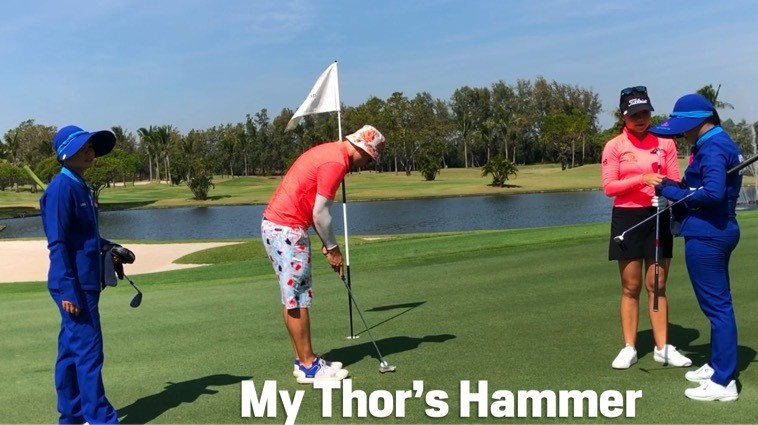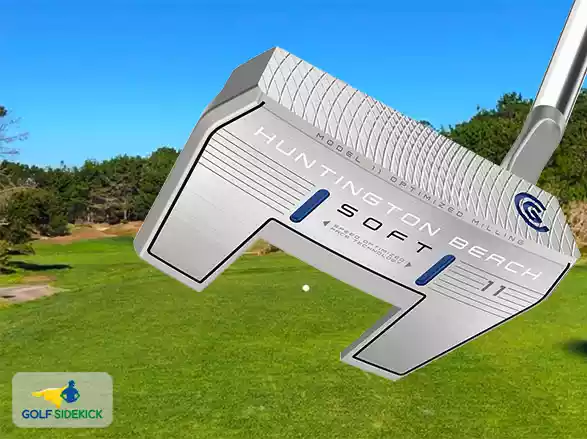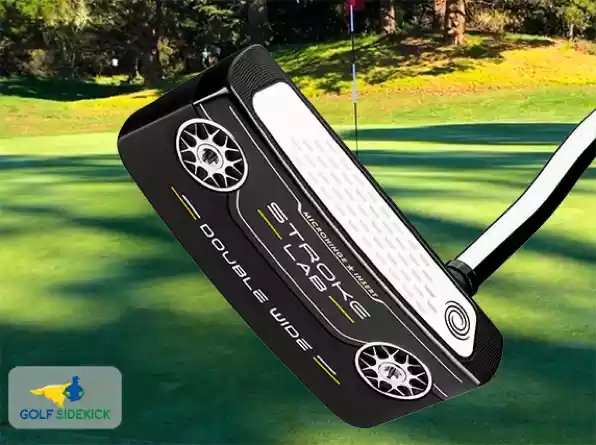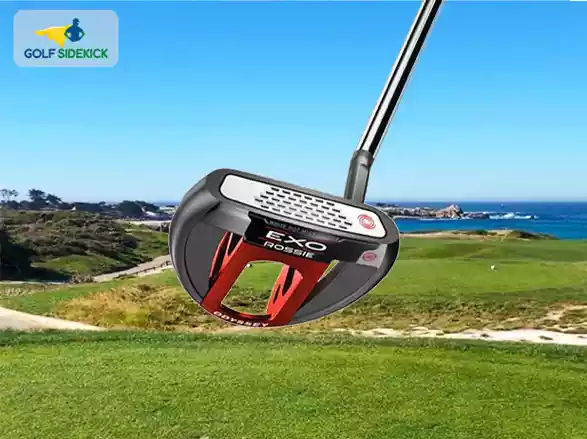Last Updated on January 14, 2024 by Matt Greene
*Read our review guidelines.
Some of us play on bikini waxed greens. And some of us play on slow bumpy greens every week.
Since moving to Asia, I play mainly on slower greens. Playing on these surfaces I have learned what is the best putter for slow greens.
I always played a blade putter, quite lightweight, on the fast bent grass greens of South Africa.
The blade works well if the green speed is high, but with most of us playing golf on slow greens, we need to change the putters we use.

On slower greens, I've discovered that lighter putters require more HIT and less stroke.
That caused me to move toward heavier, mallet style putters with great success.
Putts on slower greens need a little more 'hit' to get the ball to the hole with a lightweight blade.
With a heavier putter head, you can make a shorter stroke and get more roll out with the same stroke compared to a lightweight putter.
The Best Putters for Slow Greens
- Cleveland Huntington Beach SOFT #11 Putter (Best feel from milled steel face)
- Odyssey Stroke Lab Double Wide (Best blade style putter for slow greens)
- Odyssey EXO Rossie (Best looking putter for slow greens)
Cleveland Huntington Beach SOFT #11 Putter

This is my putter of choice at the moment. I do prefer a center shafted model which you can find here.
What drew me to this putter was not only the price, but the blue grip is slightly thicker and more built up than the standard thin grip, but mainly concentrated in the rear of the grip. It's much more comfortable than the slim grips and much more controllable than the pool noodle fat grips, which I am not fond of.
The weight of the clubhead is sufficient so that when you stroke the ball with the same length stroke as a blade putter, the ball travels an extra few feet. The face is milled steel and the milling is deep enough to force an impact on the ball that stops bouncing and sliding, rather promoting rolling.
But what the best part of this putter is the alignment aid. There is assistants on the back with the cut out piece which contrasts perfectly with the grass and with the straight edge, almost square shape, helps to align the eyes and mind and putter to the exact line.
Short putts are an absolute dream with this because it feels as if it's too big to fail. of course that's not true, but the FEELING of confidence from a putter that suits your eye is massive. This is a winner in my book.
Pros
Cons

The Stroke Lab black series feature a shaft with a graphite upper section and a steel lower section. Odyssey counter balanced the putter by adding weight near the grip and in the head. This is supposed to increase feel in a heavier putter.
The double wide is mainly in this list because it appeals to the blade fans. I am a blade fan but on slower greens, the closest I have found to a blade is this square-shaped double wide, with an extended back piece for alignment.
Hinge insert in the face creates a firmer feeling at impact instead of the typical marshmallow feel of inserts. This is a big factor if you prefer a firmer hit off the putter to gauge your strike to be able to adjust for where the sweet spot is.
It's a very simple putter but with the extra weight, it can make a transition from a traditional blade very easy or toward a blade putter from a bigger mallet.
Odyssey gave made a special effort with the weighting in the clubhead to allow for some toe hang, so that blade users, or people with an arc in their stroke can use it out the box.
Pros
Cons

Alignment is easy witht he heavy contrasting red on black, but on top of the red alignment aid, is a white line too. With alignment being of total importance to get a ball started on line, this putter gets it done best.
The face is balanced so if you have a piston-style stroke, you're going to find a lot of forgiveness and with the White Hinge face, the ball rolls end over end very quickly, in a way previous inserts have not by imparting more top spin on the ball.
But what attracted a lot of people to the Rossie in all it's iterations is that it's always been a COMPACT mallet instead of one of a massive one. The compact design makes you feel like you're hitting a blade but with the weight and heft of a mallet.
Pros
Cons
How to putt on slow greens
Remember these three things when you're playing on slow greens:
- It's not your fault - When you play on slow bumpy greens, you're going to miss some putts to start with but don't blame yourself too much. The ball can hop all over and depending on the grain of the grass it can affect the amount of break and whether the ball bounces around or not. Just realize that it's not going to all go your way and so...
- Putt for less break and hit it harder - Under-reading your putts is a good idea on slow greens since they break less. Hit the putt firmer on your line and trust the stroke. The harder 'hit' will make the ball move faster, removing a lot of the break you think is there.
- Hit short putts firm, don't baby them in - This one takes a major leap of faith and confidence in yourself. On putts inside 5 feet, pick your line, usually inside the hole and hit it firm so it slams the back of the cup. You might miss one out of ten and it will be a disaster with 6 foot back again, but you'll make 9 out of 10 and walk off with a lot more pars.
- Slow greens are difficult because of the long swing you need to make to get the ball all the way to the hole. A lot more can go wrong.
- Practice as much as you can to get used to the pace of the green. Double check with someone from the course if the practice green is similar to the course. Often the practice green is slower or faster than the course greens.
For slower greens, go heavier on the putter
For faster greens, I say lighter putters. For slower greens, I say heavier putters.
The problem we have when we look at pro's is they are playing putters given to them by sponsors.
They have no real choice in the matter so if someone is using a TaylorMade Spider on the tour on lightning fast greens, it's because they're sponsored by TaylorMade.
But what you may not know is that TaylorMade and other manufacturers will create putters specifically for the pro's to match their requirements so the weight and setup are completely different to the putters you see in the stores.
For us mere mortals, I just cannot see how a lighter putter benefits us. It creates a longer stroke, creating more ability to make an error. Heavier putters will make a shorter stroke for more consistent results overall especially on short putts on slow greens.
Do slow or fast greens break more?
Slow greens break less than fast greens.
When you play on a slow green, the ball must be hit harder, therefore it skims over a lot of the break.
If you play on fast greens, you have to hit it softer, making it roll slower for longer which means it can take more of the slope and turn much more.
Is it more difficult to putt on slow greens?
It depends what you're used to.
I find that slow greens are really difficult to putt on because they are usually unpredictable because the grass blades are longer and more variable. A fast green usually has compacted grass, cut really tight which means the ball rolls very pure and reliably with predictability.
Slow greens are good for beginners though so they can hit it firmer and worry less about hitting it too hard.
As you get better at golf, you will find that you prefer faster greens.
Greens are not inherently 'slow' or 'fast'. They are that way because of maintenance and conditioning and manicuring.
If the course is maintained and manicured well, the greens can be very true and quick. Slow greens are usually longer blades of grass either because there is no money to maintain good pure fast greens, or there is a lot of traffic so the groundskeeper needs to keep the greens shaggy to protect them from being trodden to death.
Conclusion
I hope the mini-guide and reviews above helped you find a decent putter for slow greens.
I've gamed Cleveland putters numerous times and when I played off a scratch handicap, I was playing with a Cleveland. I highly recommend them.
